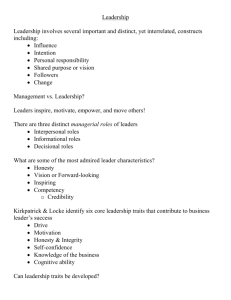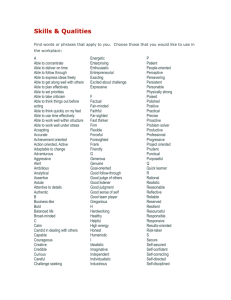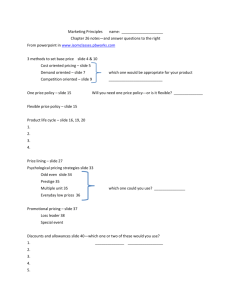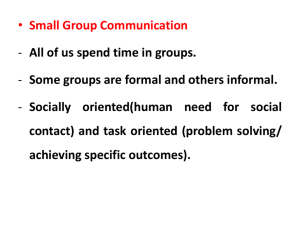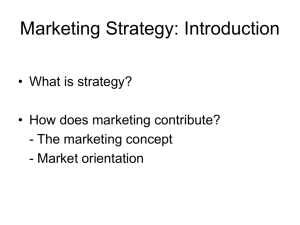ISSN: 2278-6236 WHEELERS
advertisement
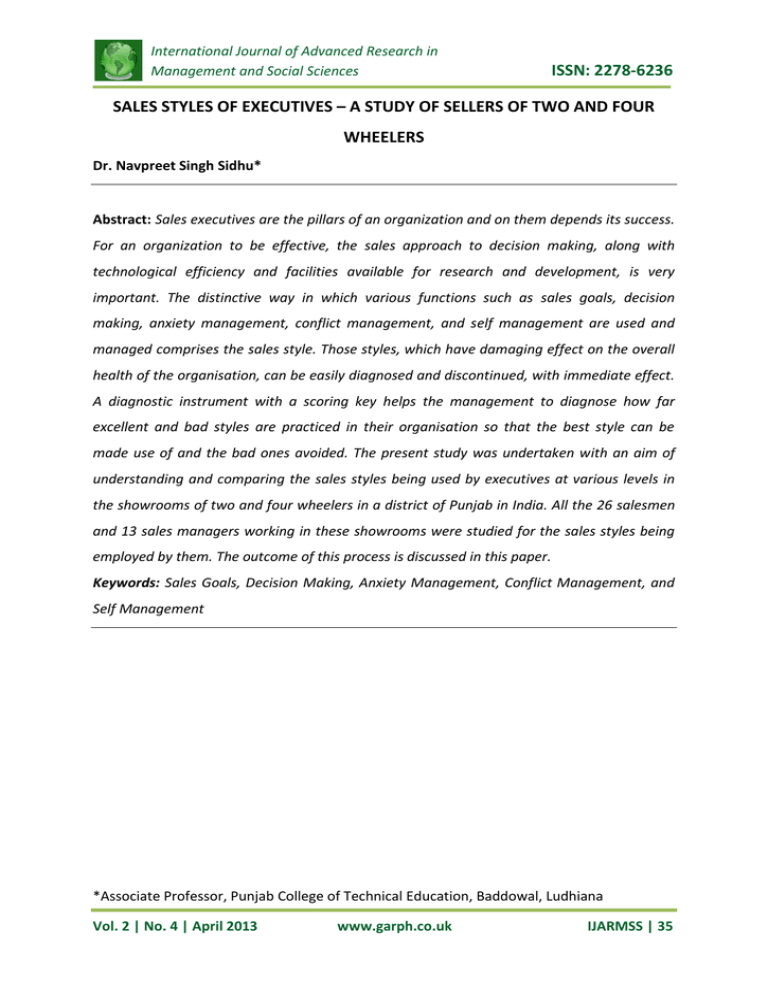
International Journal of Advanced Research in Management and Social Sciences ISSN: 2278-6236 SALES STYLES OF EXECUTIVES – A STUDY OF SELLERS OF TWO AND FOUR WHEELERS Dr. Navpreet Singh Sidhu* Abstract: Sales executives are the pillars of an organization and on them depends its success. For an organization to be effective, the sales approach to decision making, along with technological efficiency and facilities available for research and development, is very important. The distinctive way in which various functions such as sales goals, decision making, anxiety management, conflict management, and self management are used and managed comprises the sales style. Those styles, which have damaging effect on the overall health of the organisation, can be easily diagnosed and discontinued, with immediate effect. A diagnostic instrument with a scoring key helps the management to diagnose how far excellent and bad styles are practiced in their organisation so that the best style can be made use of and the bad ones avoided. The present study was undertaken with an aim of understanding and comparing the sales styles being used by executives at various levels in the showrooms of two and four wheelers in a district of Punjab in India. All the 26 salesmen and 13 sales managers working in these showrooms were studied for the sales styles being employed by them. The outcome of this process is discussed in this paper. Keywords: Sales Goals, Decision Making, Anxiety Management, Conflict Management, and Self Management *Associate Professor, Punjab College of Technical Education, Baddowal, Ludhiana Vol. 2 | No. 4 | April 2013 www.garph.co.uk IJARMSS | 35 International Journal of Advanced Research in Management and Social Sciences ISSN: 2278-6236 INTRODUCTION Sales executives are the pillars of an organization and on them depends its success. For an organization to be effective, the sales approach to decision making, along with technological efficiency and facilities available for research and development, is very important. The distinctive way in which various functions such as sales goals, decision making, anxiety management, conflict management, and self management are used and managed comprises the sales style. Those styles, which have damaging effect on the overall health of the organisation, can be easily diagnosed and discontinued, with immediate effect. Selling technique is the body of methods used in the profession of sales. According to Paul Eccher five prominent sales styles are 1. The Relationship Selling Style: This style is all about cultivating a close, personal rapport with the prospects and customers. Relationship sellers are known for their friendliness and outgoing personalities. 2. The Technical Problem-Solving Style: Sales professionals who are experts on their products and are able to educate their audience on the details of their offerings are practitioners of the Technical Problem-Solving style. These individuals tend to be quite analytical, and they excel at establishing technical credibility in front of their prospects. 3. The Account Servicing Style: Sales professionals who use this selling style focus on keeping existing customers happy while asking for more business. This serviceminded style is built upon a foundation of responsiveness, proactive follow-up, and a strong commitment to doing what is right for physicians and their patients. 4. The Assertive Style: Assertive style sales professionals sell through strength of personality. Strong assertive style reps typically bring that difficult-to-train, “fire in the belly” approach to the work. They are extremely competitive, self-assured, intense, and assertive. 5. The Business Partnering Style: Sales professionals who establish a business consulting relationship with their customers employ this style. Business Partners understand strategic issues and market conditions that influence business practices. They excel in helping their customers “grow” their businesses. Successful business Vol. 2 | No. 4 | April 2013 www.garph.co.uk IJARMSS | 36 International Journal of Advanced Research in Management and Social Sciences ISSN: 2278-6236 partners display excellent big-picture thinking skills, market knowledge, persuasive communication capabilities, and creativity. REVIEW OF LITERATURE Saxe and Weitz (1982) pointed out that the customer-oriented selling refers to the degree to which salespeople practice the marketing concept by trying to help their customers make purchase decisions that will satisfy the customers’ needs. This involves a more problem identification and problem solving approach. Adaptive selling means that salespeople change their sales strategies according to the sales situation (Weitz, Sujan, and Sujan, 1986) and leans towards customer-oriented models. (Johnston, et al., 1989; Jolson, 1999) concluded that factors inside the salesperson's own company are often responsible for poor performance — factors such as poor sales territory design, poor marketing support, and ineffective first-level sales managers. It may be said that salespeople who proactively manage these internal factors may be more successful than those who do not. According to Churchill, Ford & Walker (1993) most selling techniques confirm to one of the four philosophical orientations: (1) the stimulus-response approach, (2) mental-state approach, (3) need-satisfaction approach, and (4) problem-solution approach. The first two approaches are salesperson-oriented, rather than customer oriented. The third one involves a two-way communication between the seller and the buyer and the fourth approach involves a healthy interaction for problem solving. Marshall, et al (1999) updated the original study of Moncrief (1986) and found that the activities salespeople perform have changed markedly in recent years. Some of these newer activities are internally focused—such as making the sale and then turning it over to someone else, and coordinating with sales support. This again signals the emerging importance of the salesperson's internally-directed selling behaviors. OBJECTIVES 1. To study the sales styles of the executives of showrooms of two and four wheelers in Moga city of Punjab. 2. To compare the sales styles of the executives of showrooms of two and four wheelers in Moga city of Punjab. Vol. 2 | No. 4 | April 2013 www.garph.co.uk IJARMSS | 37 International Journal of Advanced Research in Management and Social Sciences ISSN: 2278-6236 RESEARCH METHODOLOGY For the present study both exploratory and conclusive research methods were used. The conclusive research method here is descriptive in nature and the research design is single cross-sectional. In this study primary data has been collected through survey method. The research was conducted with the help of a structured interview schedule based on a modified Sales Troika Styles (Pareek, 1997). According to this instrument the troika consists of the concern for product, customer and company. The original instrument has already been tested for reliability and validity and proposes the following styles: 1) 1,1,1 – Routine-sale oriented 2) 1,9,1 – Customer oriented 3) 9,1,1 – Product oriented 4) 9,9,1 – Solution oriented 5) 1,1,9 – Company oriented 6) 1,9,9 – Loyalty-relationship oriented 7) 9,1,9 – Company-product oriented 8) 9,9,9 – Creative-solution oriented 9) 5,5,5 – Technique oriented In the present case the target population consists of salesmen and sales managers working in the showrooms of two and four wheelers in Moga city of Punjab state in India. The unit (Kotler, 1997) in the study includes the showrooms of two and four wheelers while the elements are the sales managers and salesmen working in them. All the nine sales managers and twenty six salesmen working in these showrooms have been covered in the study. The respondents were personally administered the questionnaire and primary data was collected. The questionnaire consisted of two parts, namely, Part-A and Part-B. Part-A of the questionnaire consisted of solicited information about the profile of respondents like their age, designation etc. Part-B consisted of 18 questions based on Sales Troika Styles (relating to sales goals and decision making) proposed by Mr. Udai Pareek. This questionnaire consisted of 9 statements related to sales goals and 9 to decision making and the respondent had to answer on a five point Likert scale (Malhotra and Dash, 2010) in all the eighteen statements. Vol. 2 | No. 4 | April 2013 www.garph.co.uk IJARMSS | 38 International Journal of Advanced Research in Management and Social Sciences ISSN: 2278-6236 Analysis of data has been done by constructing suitable tables and by using other statistical techniques like mean, standard deviation, and t-test for means. Percentage method was used to analyze Part-A of the questionnaire. The percentage of respondents was calculated for each category of respondent’s profile. Part-B consisted of 18 questions. The answer sheet for this questionnaire was used for scoring. Each question had five options and the respondent had to tick on one of them. Table 1- Scores for different answer choices Score 0.5 1.0 1.5 2.0 2.5 Strongly Disagree Disagree Neither Agree nor Disagree Agree Strongly Agree HYPOTHESIS OF THE STUDY The data was analyzed using the following null hypothesis (Bajpai, 2010). HYPOTHESIS 1. Ho: There is no significant difference between the mean scores of sales styles for salesmen and those for sales managers. H1: There is a significant difference between the mean scores of sales styles for salesmen and those for sales managers. Formula used: t ( x1 x 2 ) ( 1 2 ) s12 s 22 n1 n2 df s12 s 22 n1 n2 2 2 s12 s 22 n1 n2 n1 1 n2 1 where: x1 = Mean of sample 1 Vol. 2 | No. 4 | April 2013 www.garph.co.uk IJARMSS | 39 International Journal of Advanced Research in Management and Social Sciences ISSN: 2278-6236 x 2 = Mean of sample 2 s12 = Variance of sample 1 s 22 = Variance of sample 2 n1 = Size of sample 1 n 2 = Size of sample 2 1 = Mean of population 1 2 = Mean of population 2 LIMITATIONS OF THE STUDY To understand the research findings in their right perspective, it is necessary that limitations of the study be mentioned. The present study may have suffered from the following limitations. i) Size of the sample selected for research may perhaps be considered as small, hence; the result of this study might not be fully reliable for generalization for the whole country. ii) Since the questionnaire is comparatively lengthy and the executives normally busy, there are chances that information obtained in some cases might have deviated from actual. iii) The respondents were asked to give their practical views and not the ideology, but the personal biases of the respondents might have affected the results. RESULTS AND DISCUSSION The outcome of number of respondents has been categorized in categories such as age, educational qualifications, total work experience, and levels of management. Age Age is the first and a very important factor to analyze the sales style of executives in different companies. In this study the age of respondents has been divided into four categories. Table 2 indicates that the largest group for respondents belonged to below 30 (46.15 percent) while the smallest group is for 50 and above (05.3 percent) year categories. Majority of salesmen, 69.23%, belonged to the age group of below 30 years while the rest are between 30 and 40 years of age. Vol. 2 | No. 4 | April 2013 www.garph.co.uk IJARMSS | 40 International Journal of Advanced Research in Management and Social Sciences ISSN: 2278-6236 In the sales manager category, more than two third belonged to the age group of 40-50 years. Table 2 - Frequency distribution of executives in terms of age. Age (Years) No. of Respondents Salesmen Sales Managers Below 30 18 (69.23) 30-40 08 (30.77) 02 (15.38) 40-50 09 (69.24) 50 & above 02 (15.38) Total 26 (100) 13 (100) Note: The figures in brackets indicate the percentages. Total 18 (46.15) 10 (25.64) 09 (23.08) 02 (05.13) 39 (100) Educational Background Educational background is a very important factor, which affects the behaviour of an individual to a very large extent. Table 3 indicates a majority of respondents (61.53%) were found to be having an educational level of graduation and the rest were post-graduates. Furthermore, among the salesmen around four fifth of the respondents were graduates and 19.23 percent were post-graduates. Among sales managers three-fourth of the respondents was post graduates and 23.08 percent were graduates. Table 3- Frequency distribution of executives in terms of educational qualification Educational No. of Respondents Qualification Salesmen Sales Managers Graduate 21 (80.77) 03 (23.08) Postgraduate 05 (19.23) 10 (76.92) Total 26 (100) 13 (100) Note: The figures in brackets indicate the percentages. Total 24 (61.53) 15 (38.47) 39 (100) Total Work Experience The next important factor under study was the total work experience of the executives. On the basis of the total work experience the executives were classified into four categories, i.e. i) Less than 5 years, ii) Between 5 and 10 years, iii) Between 10 and 15 years, iv) Above 15 years. Table 4 shows that a majority of the sales executives have an experience of less than 10 years. Vol. 2 | No. 4 | April 2013 www.garph.co.uk IJARMSS | 41 International Journal of Advanced Research in Management and Social Sciences ISSN: 2278-6236 In case of salesmen nearly 60 percent have an experience of less than 5 years and the rest being divided in the categories of between 5 and 10, and between 10 and 15 years. At the sales manager level, over fifty percent of the respondents have an experience which is above 15 years; the rest being equally divided in the categories from 5 to 15 years. Table 4- Frequency distribution of executives in terms of total work experience Total Work No. of Respondents Experience (Years) Salesmen Sales Managers Less than 5 15 (57.69) 5-10 07 (26.92) 03 (23.08) 10-15 04 (15.39) 03 (23.08) Above 15 07 (53.84) Total 26 (100) 13 (100) Note: The figures in brackets indicate the percentages. Total 15 (38.46) 10 (25.64) 07 (17.95) 07 (17.95) 39 (100) Level of Management Table 5 shows that the number of salesmen is exactly the double of the number of sales managers. Table 5 – Frequency distribution of executives in terms of level of management Level of Management Salesmen Sales Managers Total No. of Respondents 26 13 39 Percentage 66.67 33.33 100 Analysis of Sales Styles of Executives 1. Ranking of the Sales Styles being employed by Executives Table 6 shows that 9,1,1 – Product oriented and 1,9,1 – Customer oriented are the top two styles for both the categories while the third rank for salesmen and sales managers are being taken by 1,1,1 – Routine-sale oriented and 9,9,1 – Solution oriented respectively . Table 6 – Ranking of the sales styles being employed by sales executives based on the mean scores Rank Style 1. Salesmen 9,1,1 – Product oriented Sales Manager 9,1,1 – Product oriented 2. 1,9,1 – Customer oriented 1,9,1 – Customer oriented 3. 1,1,1 – Routine-sale oriented 9,9,1 – Solution oriented Vol. 2 | No. 4 | April 2013 www.garph.co.uk IJARMSS | 42 International Journal of Advanced Research in Management and Social Sciences 2. ISSN: 2278-6236 4. 9,9,1 – Solution oriented 1,1,1 – Routine-sale oriented 5. 9,9,9 – Creative-solution oriented 6. 1,9,9 – Loyalty-relationship oriented 5,5,5 – Technique oriented 7. 9,9,9 – Creative-solution oriented 1,9,9 – Loyalty-relationship oriented 1,1,9 – Company oriented 8. 9,1,9 – Company-product oriented 5,5,5 – Technique oriented 9. 1,1,9 – Company oriented 9,1,9 – Company-product oriented Two-Sample Analysis Results Hypothesis Ho: There is no significant difference between the mean scores of sales styles for salesmen and those for sales managers. H1: There is a significant difference between the mean scores of sales styles for salesmen and those for sales managers. (Variable 1: Salesmen, Variable 2: Sales Manager) 1) 9,1,1 – Product oriented t-Test: Two-Sample Assuming Unequal Variances Variable 1 Variable 2 Mean 4.461538462 4.692307692 Variance 0.498461538 0.230769231 Observations 26 13 Hypothesized Mean Difference 0 df 33 t Stat -1.200961154 P(T<=t) one-tail 0.11915784 t Critical one-tail 1.692360456 P(T<=t) two-tail 0.23831568 t Critical two-tail 2.03451691 Result: Since the calculated value is less than the critical value, so, do not reject Ho Vol. 2 | No. 4 | April 2013 www.garph.co.uk IJARMSS | 43 International Journal of Advanced Research in Management and Social Sciences ISSN: 2278-6236 2) 1,9,1 – Customer oriented t-Test: Two-Sample Assuming Unequal Variances Variable 1 Variable 2 Mean 4.384615385 4.461538462 Variance 0.566153846 0.435897436 Observations 26 13 Hypothesized Mean Difference 0 df 27 t Stat -0.327093281 P(T<=t) one-tail 0.373059891 t Critical one-tail 1.703288035 P(T<=t) two-tail 0.746119782 t Critical two-tail 2.051829142 Result: Since the calculated value is less than the critical value, so, do not reject Ho 3) 9,9,1 – Solution oriented t-Test: Two-Sample Assuming Unequal Variances Variable 1 Mean 4 4.076923077 Variance Observations Hypothesized Mean Difference 0.96 0.41025641 26 13 0 df t Stat Variable 2 34 -0.293948176 P(T<=t) one-tail 0.385292279 t Critical one-tail 1.690923455 P(T<=t) two-tail 0.770584557 t Critical two-tail 2.032243174 Result: Since the calculated value is less than the critical value, so, do not reject Ho Vol. 2 | No. 4 | April 2013 www.garph.co.uk IJARMSS | 44 International Journal of Advanced Research in Management and Social Sciences ISSN: 2278-6236 4) 1,1,1 – Routine-sale oriented t-Test: Two-Sample Assuming Unequal Variances Variable 1 Variable 2 Mean 4.269230769 3.846153846 Variance 0.844615385 0.474358974 Observations 26 13 Hypothesized Mean Difference 0 df 31 t Stat 1.610925665 P(T<=t) one-tail 0.058666362 t Critical one-tail 1.695518677 P(T<=t) two-tail 0.117332723 t Critical two-tail 2.039514584 Result: Since the calculated value is less than the critical value, so, do not reject Ho 5) 9,9,9 – Creative-solution oriented t-Test: Two-Sample Assuming Unequal Variances Variable 1 Variable 2 Mean 2.730769231 3.615384615 Variance 0.444615385 0.58974359 26 13 Observations Hypothesized Mean Difference 0 Df t Stat 21 -3.539439033 P(T<=t) one-tail 0.000971403 t Critical one-tail 1.720743512 P(T<=t) two-tail 0.001942806 t Critical two-tail 2.079614205 Result: Since the calculated value is more than the critical value, so, reject Ho Vol. 2 | No. 4 | April 2013 www.garph.co.uk IJARMSS | 45 International Journal of Advanced Research in Management and Social Sciences ISSN: 2278-6236 6) 1,9,9 – Loyalty-relationship oriented t-Test: Two-Sample Assuming Unequal Variances Variable 1 Mean Variable 2 3 3.461538462 Variance 0.56 0.935897436 Observations 26 Hypothesized Mean Difference 13 0 Df 19 t Stat -1.509145465 P(T<=t) one-tail 0.073855989 t Critical one-tail 1.729131327 P(T<=t) two-tail 0.147711977 t Critical two-tail 2.093024705 Result: Since the calculated value is less than the critical value, so, do not reject Ho 7) 1,1,9 – Company oriented t-Test: Two-Sample Assuming Unequal Variances Variable 1 Variable 2 Mean 2.653846154 2.923076923 Variance 0.555384615 0.576923077 Observations 26 Hypothesized Mean Difference 0 Df t Stat 13 24 -1.050052504 P(T<=t) one-tail 0.152076565 t Critical one-tail 1.710882316 P(T<=t) two-tail 0.304153131 t Critical two-tail 2.063898137 Result: Since the calculated value is less than the critical value, so, do not reject Ho Vol. 2 | No. 4 | April 2013 www.garph.co.uk IJARMSS | 46 International Journal of Advanced Research in Management and Social Sciences ISSN: 2278-6236 8) 5,5,5 – Technique oriented t-Test: Two-Sample Assuming Unequal Variances Variable 1 Variable 2 Mean 2.846153846 2.923076923 Variance 0.295384615 0.41025641 Observations 26 13 Hypothesized Mean Difference 0 Df 21 t Stat -0.371305329 P(T<=t) one-tail 0.35706493 t Critical one-tail 1.720743512 P(T<=t) two-tail 0.71412986 t Critical two-tail 2.079614205 Result: Since the calculated value is less than the critical value, so, do not reject Ho 9) 9,1,9 – Company-product oriented t-Test: Two-Sample Assuming Unequal Variances Variable 1 Variable 2 Mean 2.692307692 2.769230769 Variance 0.621538462 0.358974359 Observations 26 13 Hypothesized Mean Difference 0 Df 31 t Stat -0.338901929 P(T<=t) one-tail 0.368484301 t Critical one-tail 1.695518677 P(T<=t) two-tail 0.736968603 t Critical two-tail 2.039514584 Result: Since the calculated value is less than the critical value, so, do not reject Ho CONCLUSIONS As is evident from the discussion, 9,1,1 – Product oriented, 1,9,1 – Customer oriented, 1,1,1 – Routine-sale oriented, and 9,9,1 – Solution oriented styles are being used primarily by the sales executives both at salesman as well as sales manager level whereas the most complete style i.e. 9,9,9 – Creative-solution oriented lies at the fifth rank for sales managers and at seventh rank for salesmen which is not a healthy trend. Vol. 2 | No. 4 | April 2013 www.garph.co.uk IJARMSS | 47 International Journal of Advanced Research in Management and Social Sciences ISSN: 2278-6236 The results of the t-test show that there is no significant difference between the nine sales styles executives working at salesmen and sales manager levels except for 9,9,9 – Creativesolution oriented style which is used quite less at salesman level. RECOMMENDATIONS 1. The principal styles used by sales executives are 9,1,1 – Product oriented, 1,9,1 – Customer oriented which are NOT-OK styles so; it is required that suitable training is provided to the managers so that more of OK style of 9,9,9 – Creative-solution oriented is used. It has to be explained that all the three dimensions of product, customer and company need to be kept in mind while making a sale. 2. The scores for 9,9,9 – Creative-solution oriented style is quite low. An attempt for changing the behavioral patterns for such styles should be made. REFERENCES 1. Bajpai, N. (2010). Business Statistics, Pearson, 346-347. 2. Churchill, G. A., Ford, N. M., & Walker, O. C. (1993). Sales Force Management, Irwin (Homewood, IL), 124. 3. Johnston, M. W., Hair Jr., J. F., & Boles, J. (1989). Why do salespeople fail? Journal of Personal Selling and Sales Management, 9(3), 53-58. 4. Jolson, M. A. (1999). When salespeople fail: Assessing blame. Industrial Marketing Management, 28(1), 19-26. 5. Kotler, P. (1997). Marketing Management Analysis, Planning, Implementation, and Control, Prentice Hall of India, 117-123. 6. Malhotra, N.K., & Dash, S. (2009). Marketing Research: An Applied Orientation, Prentice Hall of India, 76-91, 274-275. 7. Marshal, G. W., Moncrief, W. C., & Lassk, F. G. (1999). The current state of sales force activities. Industrial Marketing Management, 28(1), 87-98. 8. Moncrief, W. C. (1986). Selling activity and sales position taxonomies for industrial salesforces. Journal of Marketing Research, 23(3), 261-270. 9. Pareek, U. (1997). Training Instruments For Human Resource Development, Tata Mcgraw-Hill Publishing Company Limited, 316-322, 446-449. 10. Saxe, R., & Weitz, B. A. (1982). SOCO scale: A measure of the customer orientation of salespeople. Journal of Marketing Research, 19(3), 343-351. Vol. 2 | No. 4 | April 2013 www.garph.co.uk IJARMSS | 48 International Journal of Advanced Research in Management and Social Sciences ISSN: 2278-6236 11. Selling Styles. [Online] Available http://www.salesmanhelp.com/products/download.php?file=Selling%20styles.pdf December 25, 2012. 12. Weitz, B. A., Sujan, H., & Sujan, M. (1986). Knowledge, motivation and adaptive behaviour: A framework for improving selling effectiveness. Journal of Marketing, 50(4), 177-191. Vol. 2 | No. 4 | April 2013 www.garph.co.uk IJARMSS | 49

